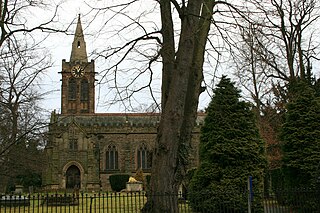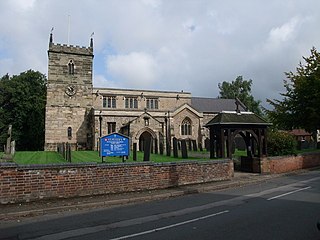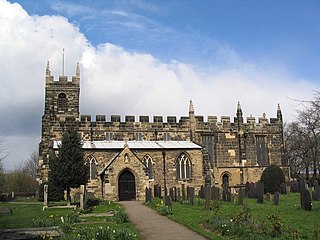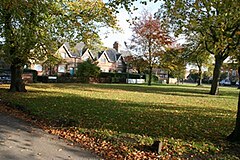
Nottinghamshire is a ceremonial county in the East Midlands of England. The county borders South Yorkshire to the north-west, Lincolnshire to the east, Leicestershire to the south, and Derbyshire to the west. The largest settlement is the city of Nottingham (323,632).

West Bridgford is a town and the administrative centre of the Borough of Rushcliffe in the county of Nottinghamshire, England. It lies immediately south of Nottingham, east of Wilford, north of Ruddington and west of Radcliffe-on-Trent. It is southwest of Colwick and southeast of Beeston which are on the opposite bank of the River Trent. The town is part of the Nottingham Urban Area and had a population of 48,225 in a 2018-estimate.

Ruddington is a large village in the Borough of Rushcliffe in Nottinghamshire, England. The village is 5 miles (8 km) south of Nottingham and 11 miles (18 km) northwest of Loughborough. It had a population of 6,441 at the 2001 Census, increasing to 7,216 at the 2011 Census.

Rushcliffe is a constituency in Nottinghamshire represented in the House of Commons of the UK Parliament from 2019 by Ruth Edwards, a Conservative.

Nottingham South is a constituency of the Parliament of the United Kingdom, represented since 2010 by Lilian Greenwood of the Labour Party.
The Becket School is a co-educational secondary Catholic school with academy status in West Bridgford, Nottinghamshire, England. It was formed in 1976 by the amalgamation of two schools, Corpus Christi Bi-Lateral School and Becket Grammar School for Boys. It is one of three Catholic secondary schools in the Greater Nottingham area, along with Christ the King and Trinity School.

Clifton is a large suburban village and historic manor in the city of Nottingham, England. As of 2021 it had a population of 22,936.

East Bridgford is a village and civil parish in the Rushcliffe borough of Nottinghamshire, east of the city of Nottingham. It had a population of 1,814 at the 2011 census. The village adjoins the south bank of the River Trent, opposite the village of Gunthorpe. It is on the Trent Valley Way. East Bridgford's an annual village show is run by the village Horticultural Society, established in 1864, and held every Feast Week.

Wilford Hill is the highest point in West Bridgford, giving views of the Trent Valley as far as Newark-on-Trent. It is listed as having an elevation of 87m and a prominence of 49m.

Abel Smith of Wilford House in the parish of Wilford, near Nottingham, England, was one of the leading bankers of his time and served thrice as a Member of Parliament.

Abel Smith III of Wilford House in the parish of Wilford, near Nottingham, England, was a British banker and politician who sat briefly in the House of Commons from 1778 to 1779.

Silverdale Estate is a place in Nottingham, England.

The Manor of Clifton was a historic manor situated near the City of Nottingham, England. The manor house, known as Clifton Hall is situated on the right bank of the River Trent in the village of Clifton, Nottinghamshire,. about 3+1⁄2 miles south-west of the historic centre of the City of Nottingham, now partly the campus of Nottingham Trent University and partly a large council estate of modern housing.

Smith's Bank was a series of English banking partnerships in London and the provinces, all controlled by the Smith family that operated between 1658 and 1918. Although Smith's Bank was never a single entity, the first bank was established in Nottingham by Thomas Smith; often dated to 1658, it is believed to be the first bank to be formed outside London.

Wilford Toll Bridge, locally referred to as the 'Halfpenny Bridge', is a tram, pedestrian and cycle bridge in Nottingham, England. It crosses the River Trent between the Meadows and Wilford. It originally opened as a toll bridge for general traffic in 1870, but was closed when declared unsafe in 1974. Following demolition of the central span, a narrower footbridge and cycleway was opened in 1980. The bridge was once again widened to accommodate an extension of the Nottingham Express Transit network in 2015.

St Wilfrid's Church, Wilford is a Grade II* listed parish church in the Church of England in Wilford, Nottinghamshire, England.

Screveton is an English parish and village in the Rushcliffe borough of Nottinghamshire, with about 100 inhabitants, increasing to 191 at the 2011 Census. It was formerly in Bingham Rural District and before 1894 in Bingham Wapentake. It is adjacent to Kneeton, Flintham, Hawksworth, Scarrington, Little Green and Car Colston.

The Trent Bridge Inn is a pub in West Bridgford, Nottinghamshire, England. The Trent Bridge Cricket Ground began in a field behind this pub, and the land was also the first home of the Notts County Football Club. The pub is now operated by Wetherspoons.



































